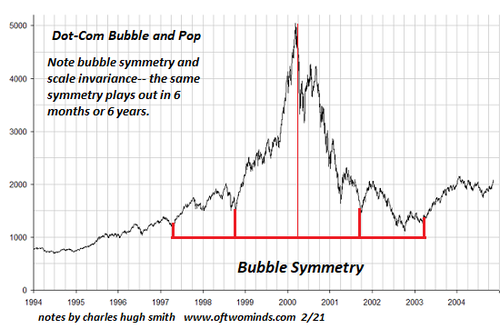The "wait and see" economy is about to face its moment of truth, and one truth is the $1.9 trillion being passed out like candy is already spent.
The defining phrase of the U.S. economy for the past year is "wait and see": every enterprise impacted by the pandemic that didn't close immediately has been in "wait and see" mode, clinging on to the hope that once the pandemic ends then everything will roar back to life, bigger and better than before.
With the promise of herd immunity fast approaching, the moment of truth for "wait and see" is also fast approaching. The conventional view is that the trillions of dollars in stimulus kept business as usual alive and ready to soar back to the good old days. The almost $2 trillion injection of financial smack currently in progress will ignite the afterburners and the economy will rocket higher than anyone can imagine.
The problem with this rosy view is the economy was on fumes before the pandemic, as Gordon Long and I highlighted in our 53-minute presentation, The Coming Deflationary Tsunami. Interest rates had been falling for 40 years and there was little leeway for more of the magic of falling rates. The spending of the upper middle class had already rolled over as the awareness that the longest expansion in U.S. history was faltering seeped into financial decisions--and no wonder, since every trick in the book had been required to keep it alive: zero interest rates, quantitative easing galore, tax cuts, massive deficit spending and speculative bubbles in every asset class.
Then there was the spot of bother in the repo markets. Something had broken in the financial plumbing (a massive break in the sewers?) and the Federal Reserve rushed freshly printed billions to stop the sewage from seeping into the precarious economy.
Though nobody dared discuss it, the economy was creaking under the burden of overcapacity in just about everything: too many cafes, too many channels of this and that, too many office towers built for get-rich-quick techies planning to sell out to Big Tech and retire at 25, too many resorts, and so on.
One driver of the overcapacity was the rise of Zombie Corporations--companies that only remain among the living if they can borrow ever more money at lower rates to fill the holes in their balance sheets and cash flow. The Fed's implicit goal was to never let a single Zombie die because that might send the wrong signal, i.e. that creative destruction was allowed. Creative destruction is no longer allowed by the Fed, never ever ever. So the economic landscape is cluttered with Fed zombies.
Also ignored was the inconvenient fact that wages for the bottom 95% have stagnated for decades and so where was all this money being blown coming from? From debt, of course, and the phantom wealth generated by speculative bubbles.
Then there are the demographic headwinds illuminated by Chris Hamilton, most recently in The Narrative Of Inflation Amid Depopulation. The working-age population has leveled off, along with the expansion of employment, while the number of those with claims on future earnings-- the elderly and those "permanently out of the workforce"--are rising.
As Chris points out, speculative asset bubbles are just peachy for those who already own the assets--the top 10% who own close to 90% of financial assets--but of little value to the bottom 90% who get a pathetic 3% of all capital income.
Those greatly enriched by the Fed's bubble-blowing are mostly older, those who can't afford homes and other inflated assets are mostly younger, burdened with stagnant wages, student loan debts and an economy that's rigged to favor the few at the expense of the many.
A great many young people are delaying or foregoing marriage and having children because they don't have the means and security do so. So who's going to be paying all the taxes needed to fund the enormous retirement and healthcare costs of 70 million retirees? No problem, we'll just borrow another couple trillion a year forever. (Free fish for everyone forever!)
Nice, but the rest of the world has opted out of buying into our funny-money fantasies. So the Fed will have to buy all the trillions in bonds being issued, and that unleashes second-order effects that have the potential to go non-linear, i.e. actually have negative consequences in the real world.

Then there's the private changes in behaviors and risk assessment that add up to tidal changes in the economy. People are reassessing their exposure to risk, and letting go of activities and expenses they once took for granted. Maybe the $300 trips to the ballpark are no longer worth it; maybe the costs of eating out are recognized as unaffordable.
The majority of residents in over-touristed locales no longer want tourism at the same scale. Residents discovered that once the tourists were gone, life was good, even if the tourist-dependent businesses closed and unemployment rose.
Everyone is holding their breath waiting to surface, but many of the enterprises that have clung on in "wait and see" mode will find that things have changed, and time cannot be reversed to summer 2019. All those holding defaulted loans based on a full return to summer 2019 are also holding their breath, hoping that the back rent will be paid in full, the overdue mortgages paid in full, and so on.

The reality is overcapacity, over-indebtedness and stagnant earnings are all deflationary. The "wait and see" economy is about to face its moment of truth, and one truth is the $1.9 trillion being passed out like candy is already spent--as is the economy and the Fed's bag of tricks
Commenti
Posta un commento